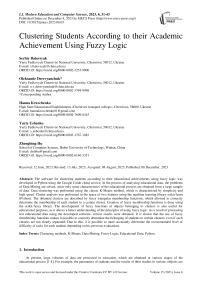Clustering Students According to their Academic Achievement Using Fuzzy Logic
Автор: Serhiy Balovsyak, Oleksandr Derevyanchuk, Hanna Kravchenko, Yuriy Ushenko, Zhengbing Hu
Журнал: International Journal of Modern Education and Computer Science @ijmecs
Статья в выпуске: 6 vol.15, 2023 года.
Бесплатный доступ
The software for clustering students according to their educational achievements using fuzzy logic was developed in Python using the Google Colab cloud service. In the process of analyzing educational data, the problems of Data Mining are solved, since only some characteristics of the educational process are obtained from a large sample of data. Data clustering was performed using the classic K-Means method, which is characterized by simplicity and high speed. Cluster analysis was performed in the space of two features using the machine learning library scikit-learn (Python). The obtained clusters are described by fuzzy triangular membership functions, which allowed to correctly determine the membership of each student to a certain cluster. Creation of fuzzy membership functions is done using the scikit-fuzzy library. The development of fuzzy functions of objects belonging to clusters is also useful for educational purposes, as it allows a better understanding of the principles of using fuzzy logic. As a result of processing test educational data using the developed software, correct results were obtained. It is shown that the use of fuzzy membership functions makes it possible to correctly determine the belonging of students to certain clusters, even if such clusters are not clearly separated. Due to this, it is possible to more accurately determine the recommended level of difficulty of tasks for each student, depending on his previous evaluations.
Clustering methods, K-Means, Data Mining, Fuzzy Logic, Educational Data, Python
Короткий адрес: https://sciup.org/15019142
IDR: 15019142 | DOI: 10.5815/ijmecs.2023.06.03
Список литературы Clustering Students According to their Academic Achievement Using Fuzzy Logic
- R. Ahuja, A. Jha, R. Maurya and R. Srivastava, Analysis of Educational Data Mining. In Harmony Search and Nature Inspired Optimization Algorithms, Springer: Singapore, 2019, pp. 897–907. doi: 10.1007/978-981-13-0761-4_85.
- H. Aldowah, H. Al-Samarraie and W.M. Fauzy, “Educational data mining and learning analytics for 21st century higher education: A review and synthesis”, Telemat. Inform., vol. 37, pp. 13-49, 2019. doi: 10.1016/j.tele.2019.01.007.
- Vasyl Lytvyn, Olga Lozynska, Dmytro Uhryn, Myroslava Vovk, Yuriy Ushenko, Zhengbing Hu, “Information Technologies for Decision Support in Industry-Specific Geographic Information Systems based on Swarm Intelligence”, International Journal of Modern Education and Computer Science, vol. 15, no. 2, pp. 62-72, 2023.
- Shashank Mishra, Mukul Aggarwal, Shivam Yadav, Yashika Sharma, "An Automated Model for Sentimental Analysis Using Long Short-Term Memory-based Deep Learning Model", International Journal of Engineering and Manufacturing, Vol.13, No.5, pp. 11-20, 2023.
- Ihor Tereikovskyi, Zhengbing Hu, Denys Chernyshev, Liudmyla Tereikovska, Oleksandr Korystin, Oleh Tereikovskyi, “The Method of Semantic Image Segmentation Using Neural Networks”, International Journal of Image, Graphics and Signal Processing, vol. 14, no. 6, pp. 1-14, 2022.
- Sun Fayou, Hea Choon Ngo, Yong Wee Sek, “Combining Multi-Feature Regions for Fine-Grained Image Recognition”, International Journal of Image, Graphics and Signal Processing, vol. 14, no. 1, pp. 15-25, 2022.
- Enitan Olabisi Adebayo, Ibiyinka Temilola Ayorinde, “Efficacy of Assistive Technology for Improved Teaching and Learning in Computer Science”, International Journal of Education and Management Engineering, vol. 12, no. 5, pp. 9-17, 2022.
- Moez Ali. Clustering in Machine Learning: 5 Essential Clustering Algorithms. URL: https://www.datacamp.com/blog/clustering-in-machine-learning-5-essential-clustering-algorithms.
- B. Chen, J. Macintyre, J. Zhao, X. Ma, “Application of Cluster Analysis Algorithm in the Construction of Education Platform”, The 2021 International Conference on Machine Learning and Big Data Analytics for IoT Security and Privacy. SPIoT 2021. doi: 10.1007/978-3-030-89511-2_54.
- T. Prabha, D.S. Priyaa, “Knowledge Discovery of the Students Academic Performance in Higher Education Using Intuitionistic Fuzzy Based Clustering”, J. Theor. Appl. Inf. Technol, vol. 95, pp. 7005–7019, 2017.
- Mohamed Nafuri, Ahmad Fikri, Nor Samsiah Sani, Nur Fatin Aqilah Zainudin, Abdul Hadi Abd Rahman, and Mohd Aliff. “Clustering Analysis for Classifying Student Academic Performance in Higher Education”, Applied Sciences, vol. 12, no. 19, pp. 9467, 2022. doi: 10.3390/app12199467.
- X. Li, Y. Zhang, H. Cheng, F. Zhou and B. Yin, “An Unsupervised Ensemble Clustering Approach for the Analysis of Student Behavioral Patterns”, IEEE Access, vol. 9, pp. 7076-7091, 2021, doi: 10.1109/ACCESS.2021.3049157.
- C. Maithri, H. Chandramouli, “Parallel DBSCAN Clustering Algorithm Using Hadoop Map-reduce Framework for Spatial Data”, International Journal of Information Technology and Computer Science, vol. 14, no. 6, pp. 1-12, 2022.
- Tarik Bourahi, Azouazi Mohamed, Abdessamad Belangour. The application of fuzzy logic to improve orientation in system education in Morocco. Journal of Theoretical and Applied Information Technology, vol. 99, no. 13, pp. 3292-3305, 2021.
- Tengku Zatul Hidayah Tengku Petra, Mohd Juzaiddin Ab Aziz, “Analysing Student Performance In Higher Education Using Fuzzy Logic Evaluation”, International journal of scientific & technology research, vol. 10, no. 01, pp. 322-327, 2021.
- A. Heni, I. Jdey and H. Ltifi, “k-means and fuzzy c-means fusion for object clustering”, 8th International Conference on Control, Decision and Information Technologies (CoDIT), Istanbul, Turkey, pp. 177-182, 2022. doi: 10.1109/CoDIT55151.2022.9804078.
- T. Chen, “Guaranteed-consensus posterior-aggregation fuzzy analytic hierarchy process method”, Neural Comput & Applic., vol. 32, pp. 7057–7068, 2020. doi: 10.1007/s00521-019-04211-y.
- A. R. Fayek, “Fuzzy Logic and Fuzzy Hybrid Techniques for Construction Engineering and Management”, Journal of Construction Engineering and Management, vol. 146, no. 7, pp. 1-12, 2020. doi: 10.1061/(ASCE)CO.1943-7862.0001854.
- S.V. Balovsyak, O.V. Derevyanchuk, Ya.V. Derevianchuk, V.V. Tomash, S.V. Yarema, “Segmentation of railway transport images using fuzzy logic”, Trans Motauto World. 2022. vol. 7, no. 3. pp. 122-125, 2022.
- Scikit-Learn. URL: https://scikit-learn.org.
- Google Colab. URL: https://colab.research.google.com.
- Students performance in exams. URL: https://www.kaggle.com/datasets/spscientist/students-performance-in-exams.


